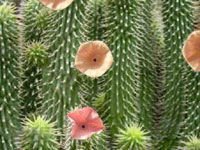The use of Hoodia has been long known by the indigenous populations of Southern Africa, who infrequently use these plants for treating indigestion and small infections.
In 1977, the South African Council for Scientific and Industrial Research (CSIR) isolated the ingredient in hoodia (now known as P57) responsible for this appetite-suppressant effect and patented it.[citation needed] The CSIR then granted United Kingdom-based Phytopharm a license, and they collaborated with the pharmaceutical company Pfizer to isolate active ingredients from the extracts and look into synthesizing them for use as an appetite suppressant. Pfizer released the rights to the primary ingredient in 2002. Paul Hutson, associate professor in the University of Wisconsin-Madison School of Pharmacy, told the Wisconsin State News, "For Pfizer to release something dealing with obesity suggests to me that they felt there was no merit to its oral use".[2] Pfizer states that development on P57, the active ingredient of Hoodia, was stopped due to the difficulty of synthesizing P57. [3] Jasjit Bindra, lead researcher for hoodia at Pfizer, states there were indications of unwanted effects on the liver caused by other components, which could not be easily removed from the supplement, adding "Clearly, hoodia has a long way to go before it can earn approval from the Food and Drug Administration. Until safer formulations are developed, dieters should be wary of using it." [4]
In 2002, CSIR officially recognized the San tribespeople’s rights over Hoodia, allowing them to take a percentage of the profits and any spin-offs resulting from the marketing of Hoodia.[5] Hoodia gordonii is a protected plant which can only be wild-harvested by individuals and the few companies who have been granted a license.[6]
Taken from
http://en.wikipedia.org/wiki/Hoodia_GordoniiFor more complete information, go to:
Dr.Hoodia #1 Recommendation
www.Hoodithin.comTo Great Health,
Dr.Hoodia
www.Hoodithin.com



